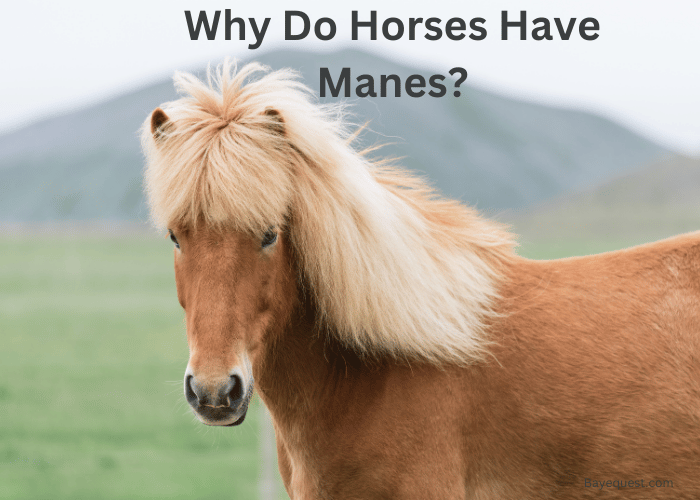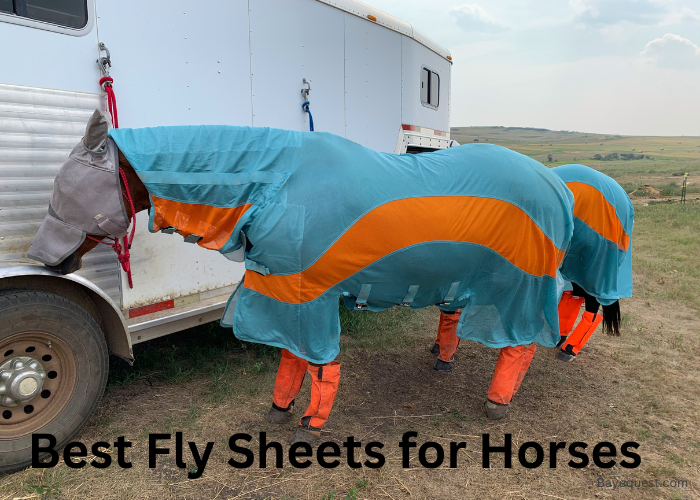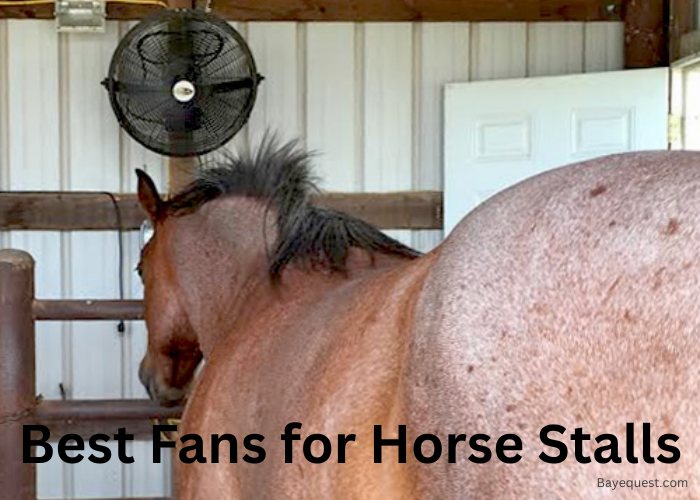A horse’s mane isn’t just about looks—it serves a purpose far beyond style.
This thick, flowing hair is a built-in shield, protecting horses from harsh weather, biting insects, and even the teeth of aggressive rivals.
But there’s more to it than defense. A horse’s mane also plays a subtle role in social interactions and communication.
Curious about why those manes truly matter? Let’s unravel the surprising reasons behind this iconic feature.
Why Do Horses Have Manes? Key Takeaway
Horses have manes for more than just beauty. They protect against harsh weather, biting insects, and aggressive bites. Manes also play a role in social interactions, helping horses communicate. This thick hair isn’t just decorative—it’s a vital feature that keeps horses safe, comfortable, and connected.
6 Reasons Why Horses Have Manes
Horse manes are more than just a beautiful feature. They serve several important purposes that go beyond appearance.
Let’s dive into why this iconic feature matters so much.
Pest control
A horse’s mane is like a built-in fly swatter. Those long, thick strands help keep bugs away from the horse’s sensitive neck.
Flies and other pests can be more than just annoying; they can cause real discomfort and even transmit diseases. The mane helps by flicking these pests off, reducing the chances of bites or irritation.
So, while it may look like a beautiful feature, the mane is doing an important job. It’s nature’s way of giving horses some relief from those persistent insects.
Protection from elements
A horse’s mane acts like a natural blanket, offering protection from the elements. When the sun is blazing, the mane provides shade, helping to prevent sunburn on the horse’s neck.
In cold weather, it adds an extra layer of warmth, keeping the chill at bay. And when it rains, the mane can help channel water away, keeping the neck drier.
Protection from adversaries
In the wild, a horse’s mane can be a lifesaver. It provides a layer of protection against bites and scratches from other animals.
During fights or scuffles, the mane can make it harder for an adversary to grab hold of the neck, reducing the risk of serious injury. This natural armor helps keep the horse safe, whether it’s facing off against a predator or another horse.
It’s one more way the mane serves a practical purpose beyond its beauty.
Marker of health for horses
A healthy mane is often a sign of a healthy horse. The condition of a horse’s mane can tell you a lot about its overall well-being.
A thick, shiny mane usually means the horse is getting the right nutrition and care. On the other hand, a thin or dull mane could be a sign of stress or poor health.
The mane is an indicator of how well a horse is doing. It’s like nature’s report card, showing how well the horse is thriving.
Communication
Horses use their manes as part of their body language. The way a horse holds or moves its mane can send signals to other horses or even to humans.
For instance, a horse might raise its mane when it’s excited or feeling threatened. This movement can communicate moods or intentions, helping horses interact with each other.
Manes are a tool for communication, adding another layer to how horses express themselves.
Grooming and bonding
Grooming a horse’s mane is more than just a beauty routine. It’s an important bonding activity.
Horses groom each other’s manes as a way to show affection and build social connections. When humans groom a horse, it helps strengthen the bond between them.
This time spent together can be calming for the horse and is a way to build trust.
Read also: How do Horses Show Affection to Humans?
Why Do Domestic Horses Have Long Manes?
Domestic horses have long manes for a few reasons. Over time, humans have selectively bred horses to emphasize this trait, valuing the beauty and the practical benefits.
A long mane protects from the elements, like shielding the neck from the sun and rain. It also helps with pest control, keeping insects at bay.
In a domestic setting, a long mane is often groomed and cared for, making it a symbol of health and good care. So, the long mane isn’t just a natural feature—it’s a result of human care and attention.
Factors That Can Affect Horse Manes
A horse’s mane can tell you a lot about its overall well-being. Several factors can influence the health and appearance of that mane, from what a horse eats to how it’s groomed.
Let’s take a closer look at what can affect a horse’s mane and why it matters.
Nutrition
A horse’s diet plays a big role in the health of its mane. If a horse gets the right balance of vitamins and minerals, its mane will likely be thick, strong, and shiny.
Poor nutrition, on the other hand, can lead to a dull, brittle mane that’s prone to breaking. So, what a horse eats directly affects how its mane looks and feels.
Grooming
Regular grooming can help maintain a healthy mane. Brushing keeps the hair free from dirt and tangles, which can prevent breakage.
However, too much or rough grooming can damage the mane, causing it to thin out or lose its natural luster.
It’s all about finding the right balance.
Environment
The environment a horse lives in can also impact its mane. Horses in wet or humid climates might struggle with mold or mildew in their manes, while those in dry, dusty areas may experience more breakage.
The weather and surroundings play a big part in how a horse’s mane holds up over time.
Health issues
A horse’s overall health can show up in its mane. Conditions like skin infections, parasites, or hormonal imbalances can lead to hair loss or a dull appearance.
If a horse isn’t feeling well, its mane might be one of the first places you’ll notice a change. Keeping a horse healthy helps keep its mane looking its best.
Stress
Just like humans, horses can experience stress, and it can take a toll on their mane. Stressful situations like moving to a new home, changes in routine, or social conflicts with other horses can cause a mane to thin out or even fall out.
Reducing stress helps maintain a fuller, healthier mane.
Is it Okay to Cut a Horse’s Mane?
Yes, it’s okay to cut a horse’s mane. Some people trim or even fully cut a horse’s mane for practical reasons, like keeping it out of the way during riding or showing.
It can also help with grooming, making it easier to keep the mane clean and tangle-free. However, you need to remember that a horse’s mane offers protection from the elements and insects.
So, if you decide to cut it, be sure to consider the horse’s environment and needs. A trimmed mane can be just as healthy as a long one if cared for properly.
Tips to Keep Your Horse’s Mane Healthy and Shiny
Here are some key tips to keep your horse’s mane healthy and shiny:
1. Brush regularly to prevent tangles.
2. Feed a balanced diet for strong, healthy hair.
3. Use gentle detangling techniques to avoid breakage.
4. Avoid harsh chemicals that can dry out the mane.
5. Wash the mane routinely with mild shampoos.
6. Protect the mane from excessive sun exposure.
7. Trim split ends to encourage healthy growth.
8. Apply moisturizing treatments to maintain softness and shine.
How Fast Do Horse Manes Grow?
Horse manes grow at a rate of about half an inch to an inch per month, depending on the horse’s breed, health, and care. Some horses might grow their manes a bit faster, while others might take longer.
Factors like nutrition, overall health, and how well the mane is maintained can all influence the growth rate. So, if you’re looking to grow out your horse’s mane, patience and proper care are key.
It might take several months to see significant length, but with the right attention, it will happen.
Braided Horse Manes with Meanings
Braiding a horse’s mane isn’t just about looking good; it can also carry meaning, especially in different cultures or traditions. Here are a few examples:
Button braids
Often used in dressage and formal events, button braids are tight and neat, symbolizing discipline and precision. They show that the horse is ready for a formal presentation.
Running braid
This braid runs along the horse’s neck and is often used for long-maned horses. It’s practical for keeping the mane out of the way during riding, symbolizing functionality and elegance.
Yarn braids
These are colorful braids, often used in parades or festive events. Each color can represent something different, like a rider’s stable colors or a special occasion.
War braids
In Native American culture, braids were sometimes used to prepare a horse for battle, symbolizing strength and readiness. They could also represent the bravery of the horse and rider.
Mane knots
These small, tight knots can be used in endurance riding, representing endurance and resilience. They keep the mane secure during long, challenging rides.
Can Horses Lose Their Manes?
Yes, horses can lose their manes. This can happen for a few reasons, like rubbing against fences or trees, skin conditions, or even stress.
Sometimes, a horse might lose part of its mane due to excessive grooming or harsh handling. Illness or poor nutrition can also cause the mane to thin out or fall out in patches.
While it’s not common for a horse to lose its entire mane, it can become damaged or thinned.
Horses With The Thickest And Longest Manes
Some horses have incredibly thick and long manes, and these breeds often stand out for their flowing locks:
1. Friesian. Known for their stunning black coats and thick, wavy manes, Friesians are often seen in movies and shows. Their manes can grow impressively long, adding to their regal appearance.
2. Gypsy Vanner. This breed is famous for its luxurious mane and tail, which are often thick and can grow down to the ground. Gypsy Vanners are a favorite for those who love the look of a horse with a full, flowing mane.
3. Andalusian. Andalusians often have thick, long manes that are a hallmark of their elegant appearance. These horses are often seen with manes that are carefully groomed and sometimes braided for shows.
4. Icelandic Horse. Despite their small size, Icelandic horses can have very thick, long manes. This helps keep them warm, especially in their natural, cold climate.
5. Paso Fino. Known for their smooth gait, Paso Finos often have long, thick manes that flow beautifully as they move, making them a standout in the show ring.
Horses With Not-So-Thick Manes
These breeds often have finer or shorter manes, which can give them a sleek, refined look:
1. Thoroughbred
Known for their speed and agility, Thoroughbreds often have finer, shorter manes. Their manes are usually kept tidy and trimmed, especially in racing and competition settings.
2. Arabian
While Arabians are known for their beauty, their manes are generally finer and not as thick as those of some other breeds. This gives them a graceful, delicate appearance that matches their elegant stature. (See also: Price of an Arabian Horse.)
3. Standardbred
Used primarily for harness racing, Standardbreds have shorter, less thick manes. Their manes are often kept trimmed to avoid getting in the way of equipment.
4. Quarter Horse
While some Quarter Horses can have thicker manes, many have manes that are on the thinner side. This is especially true for those used in Western disciplines where a neat, functional appearance is often preferred.
5. Appaloosa
Appaloosas are known for their unique coat patterns, but they often have manes that are thinner and shorter. This characteristic can vary, but it’s not uncommon for an Appaloosa to have a sparse mane.
What is the Correct Side for a Horse’s Mane?
The correct side for a horse’s mane to fall is traditionally the right side. This is often preferred in shows and competitions because it gives a neat, uniform appearance.
When a mane naturally falls to the right, it’s usually left that way. But if it falls to the left, some people might train it to go to the right by using braids or bands.
While the right side is the norm, the most important thing is that the mane is well-groomed and cared for, no matter which side it falls on.
How to Train the Horse’s Mane to Lie on One Side?
Training a horse’s mane to lie on one side is simple but takes a bit of patience. Start by wetting the mane, then gently comb it over to the side you want it to lie on.
You can use braids or bands to help keep it in place. Leave the braids or bands in for a few days, checking and redoing them as needed.
Over time, the mane will start to naturally fall to that side. Just keep up with regular grooming, and soon enough, the mane will stay put where you want it.
What is a Roached or Hogged Mane?
A roached or hogged mane is one that’s been completely shaved off. Instead of letting the mane grow out, it’s cut right down to the neck, leaving the horse with a smooth, clean look.
This style is often used for practical reasons, like making it easier to keep the horse cool in hot weather or to avoid tangling and maintenance issues.
While it might seem extreme, a roached mane can be a good choice for horses in certain disciplines or climates where a long mane isn’t practical.
FAQs
Which horses have shiny manes?
Horses with shiny manes are usually those that receive good nutrition, regular grooming, and proper care. Breeds like Friesians and Gypsy Vanners, known for their luxurious manes, often have a natural shine when well-cared for. Shiny manes are typically a sign of a healthy horse.
Do wild horses have better manes than domestic horses?
Wild horses often have manes that are rougher and more weathered due to their environment. While they may have a natural, rugged beauty, domestic horses usually have better-maintained manes. So, domestic horses generally have more polished and healthier-looking manes.
Do different riding disciplines require different styles of manes?
Yes, different riding disciplines often have specific preferences for mane styles. For example, dressage horses have neatly braided manes, while show jumpers might have a shorter, pulled mane. Western riders often prefer a more natural look, sometimes with a slight trim. Each discipline has its standard for how the mane should be styled.
Conclusion
Horse manes are more than just a beautiful feature. They’re a vital part of what makes these animals so unique.
From protecting against the elements to helping with communication, a horse’s mane plays many roles.
Whether it’s long and flowing or kept neat and tidy, the mane is a symbol of a horse’s strength and grace.
So, the next time you see a horse’s mane blowing in the wind, remember—it’s not just for show. It’s nature’s way of giving these incredible animals a little extra magic.
Now, check out our article that explains why horses bob their heads to nderstand their unique behaviors, from expressing emotions to dealing with discomfort.








